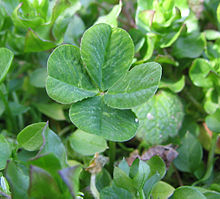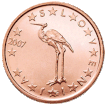Lucky charm
A lucky charm or symbol of good luck is an object (stone or jewelry pendant), a plant or parts of it, a person or an animal, which superstitious people believe has good luck. A lucky charm can usually be compared to an amulet or talisman and is supposed to help you to happiness, prosperity, health and a long life as well as to keep evil away. Mostly because of the historical past or because of a legend, a living being or object is seen as a good luck charm; the bearer of good news is also referred to as such.
The relationship between the lucky charm and the rather ideal symbol of happiness is ambivalent - in order to turn it into a lucky charm , all that is really needed is an appropriately “tangible” form or representation. Conversely, the very thought of it can (again) turn it into a symbol of happiness . So it depends on the individual point of view.
Different lucky charms
Four-leaf clover
Since four-leaved leaves of the clover (or wood sorrel ) are very rare in nature ( mutations ), it takes a lot of luck to find such a clover. Here it is supposedly important that the shamrock was found accidentally and was not bred. (Cultivated shamrocks, on the other hand, are said to attract bad luck.) When you travel with you, the shamrock protects the wearer from misfortune; if you sew it into clothing, it is supposed to protect you from evil.
The legend goes as follows: The biblical figure Eva took a four-leaf clover with her as a souvenir from Paradise. It is said that the owner of a four-leaf clover owns a piece of paradise .
In most cases, however, due to a lack of luck, one is satisfied with the luck symbol as such - on cardboard, on paper or virtually (e.g. website) - or with an appropriately shaped pendant (especially for children). Today very few people own or know a real, naturally grown shamrock, except as a cultivation by the gardener.
According to reports, there are collectors who have found several thousand four-leaf clover.
Lucky penny
The lucky penny is a symbol of wealth. By giving it away - physically and symbolically - you wish the recipient that he will never run out of money.
Historical background: The lucky penny is often seen as a smaller version of the golden baptismal coin or the consecrated groschen , which in earlier centuries - in the hope of driving out witches - was nailed to the stable door or always carried with you. Due to the current situation, the 1- cent piece is now taking its place.
Since the Slovenian 1 cent coin bears a stork motif, it is increasingly popular as a gift for pregnancy or the birth of a child.
Ladybug
The ladybug is considered to be the heavenly messenger of the Mother of God. He is supposed to protect the children and heal the sick when he comes to them. However, one must never shake it off or even kill it, because otherwise one attracts misfortune.
Ladybugs are a popular motif on greeting cards and postage stamps and in art. The name ladybird also indicates this: Because of their usefulness for agriculture, the farmers believed that the beetles were a gift from Mary (mother of Jesus) and named them after her. The seven-point ladybug is called “Mary's key maid” in Sweden. The seven points are meant to refer to the seven virtues of St. Mary. There were and are true ladybug cults, which were primarily religious.
Fly agaric
Actually poisonous, the physical possession of a toadstool is no longer desired, but the symbol of luck seen in it .
The exact derivation of this very popular symbol is not known. Presumably because of its psychoactive effects, the toadstool has always been associated with sorcery; probably also its extravagant appearance contributes to its popularity as a lucky charm.
Hare paw
The paw of a rabbit is considered auspicious talisman , but it must be a real rabbit's foot.
horseshoe
Since the horse has always been seen as a symbol of strength and power and therefore as a noble and valuable animal, the horseshoe that protected the animal was also considered a good luck charm. After horse shoeing was invented by the Romans , the horseshoe developed into a good luck charm for almost all peoples, as it protected the valuable horse. Finding a horseshoe, in particular, brought the farmers luck.
In the past, a horseshoe was often attached to the mast of a ship to ensure safe travel. Attached to a door bar, it is supposed to protect the house and the yard and prevent strangers or evil spirits from entering. Suspended on a nail above the door, the horseshoe is supposed to fall on the devil's head when he wants to enter the house in human form.
There are several versions for aligning the horseshoe, on the one hand an iron that is open at the top is a symbol for the devil's horns, on the other hand it is also a well that catches luck. Opened at the bottom, however, there is the idea that luck can "fall out". A horseshoe open to the right represents a C for " Christ ".
Lucky pig
The boar was already a sacred animal for the Germanic peoples . The chariot of the god Freyr is pulled by the boar Gullinborsti . The pig is therefore a symbol of prosperity and wealth, as it is considered a symbol of fertility and strength. In addition, the Greeks and Romans were considered privileged to have a lot of pigs and thus ultimately food. Usually - especially on New Year's Eve - no live piglet is given away, but a symbolic replica, mostly made of marzipan . The pig is often combined with a chimney sweep as a rider and a lucky penny or four-leaf clover in its mouth. “ To have a pig ” is a saying and means “to be lucky”.
In Eastern European countries like Ukraine , however, pigs are associated with something negative. It is considered to be “unclean” by Jews and Muslims and there are religious prohibitions on consumption .
mistletoe
According to German popular belief, mistletoes protect against witches . They were hung in houses and stables to protect people and livestock. This plant was also said to have healing powers.
A kiss between two lovers under a mistletoe is a good omen for the couple's imminent wedding.
chimney sweeper
It used to be a household disaster if the chimney was clogged or poorly drafted, because then the food could no longer be prepared and it would get cold in the house. In such a situation, the chimney sweeper brought the rescue. He cleaned the chimney (chimney) and it was possible to cook and heat again. So he brought back "happiness". Today it is said to bring good luck to touch a chimney sweep or to touch the golden button (alternatively the jacket). Cleaning the chimney also had the advantage that the accumulated soot did not ignite as quickly and there was no fire in the house.
Fatima's hand
Especially in the Arabic / Islamic world, the hand of Fatima is a popular symbol and template for countless pendants.
Lucky Feet (India)
Stickers with small footprints welcome visitors on many doorsteps, especially in northern India. The traces belong to the Hindu goddess Lakshmi and are said to give luck, wealth and harmony.
Maneki Neko (Japan)
Maneki Neko is the name of a small porcelain cat that waves a paw and is said to guarantee happiness and prosperity. If she waves her right, it means prosperity. If she waves her left paw, it means luck. It should beckon the people in from the street and thus happiness.
Daruma (Japan)
Daruma is a paper mache figure who represents the Buddhist monk Bodhidharma. The lucky charm should help to fulfill wishes.
Four monkeys (Japan)
See three monkeys
Horn (Naples)
The horn ( corno, cornicello ) is a lucky charm in the form of a pepper, which is supposed to help against the evil eye. It was already common in ancient Pompeii .
Tibetan lucky symbols
The eight Tibetan symbols of good luck that are common in several Indian religions (including Buddhism, Hinduism and Jainism) also in India and China are:
Scarab (Ancient Egypt and other ancient countries)
In ancient Egypt , the scarab , a stone in the shape of a beetle, was a common good luck charm. Scarabs were also found in Phoenician and Punic tombs, so they were probably spread beyond Egypt.
swastika

In Hinduism , Buddhism and Jainism , the swastika is a widespread symbol of good luck.
Dice (game dice)
The cube represents fate and the unpredictable sides of life. The dice is not only supposed to bring luck in gambling, but is also used as a New Year's greeting gift to symbolize luck. The fuzzy dice in the car is supposed to bring happiness to the occupants while driving.
Opposite: bad luck charm
Also rooted in popular belief are bad luck charms that are said to conjure up disaster. An example of this is the black cat , which is said to be home to the devil . Even today, black cats and dogs are considered difficult to place in animal shelters because they are assumed to be more aggressive. Actions intended to cause misfortune are common. Breaking a mirror , going under a ladder or spilling salt can be mentioned here. Often there is a suitable antidote for the bad luck charm , e.g. B. Throw the spilled salt over your shoulder.
Web links
Individual evidence
- ↑ Lucky clover. Retrieved July 30, 2012 .
- ^ Heider in shamrock fever. (No longer available online.) Archived from the original on October 22, 2012 ; Retrieved July 30, 2012 . Info: The archive link was inserted automatically and has not yet been checked. Please check the original and archive link according to the instructions and then remove this notice.
- ↑ Archive link ( Memento of the original from May 20, 2010 in the Internet Archive ) Info: The archive link was inserted automatically and has not yet been checked. Please check the original and archive link according to the instructions and then remove this notice.
- ↑ Don't be afraid of black dogs! , Berliner Morgenpost from February 22, 2012.




